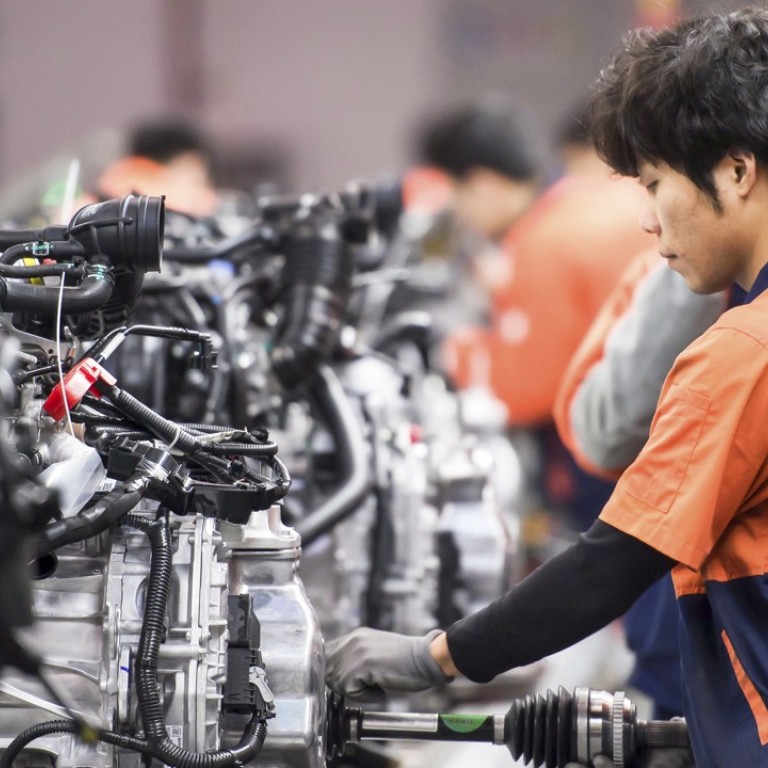
Is Beijing going back to the future with its much-hyped ‘Made in China 2025’ plan?
Washington has singled out the industrial strategy in its trade row but precedent points to trouble on the ground
When the eastern Chinese city of Huzhou announced the recipients of its “Made in China 2025” subsidies last year, one of the biggest winners was milk tea maker Xiangpiaopiao.
The company, best known for its ubiquitous instant drinks, walked away with 16.56 million yuan (US$2.49 million), or about 10 per cent of the city’s funds for the scheme, to set up a new “smart” liquid milk tea factory.
Made in China 2025 is the central government’s big plan to move China up the global value chain and establish it as the dominant force in the technologies of the future.
Washington sees it as a well-defined, well-orchestrated strategy and seeks to undermine it with tariffs imposed late last week.
But Lu Jiun-wei, a deputy researcher with the Taiwan Institute of Economic Research, said using Made in China 2025 subsidies for milk tea production reflected an old patten of “there’s a policy above, and there’s a way below”, meaning well-intended policy could be distorted during implementation.
“It is still an old model that Made in China 2025 has to face,” Lu said.
The company, which is listed, declined to comment, and the Huzhou authority in charge of granting the subsidies did not reply to a request for comment.
Huzhou in Zhejiang province is one of dozens of cities Beijing has approved as pilot centres for the plan unveiled three years ago. The idea is to support innovative, green and advanced technology but analysts said that so far it was more of a broad vision than a concrete plan.
Zhong Wei, a finance professor at Beijing Normal University, said the central government had made no arrangements for the plan in terms of personnel, budgets or resource allocation.
One more substantial part of the plan is the 51.61 billion yuan Beijing earmarked last year for local Made in China 2025 plans.

In their quest for those funds, many provincial and municipal authorities have dusted off their regional industrial development blueprints and rebranded the strategies and subsidies as Made in China 2025 ones, according to a report released online on May 30 by the National Manufacturing Strategy Advisory Committee, a body advising the government.
The report, co-authored by Huang Qunhui, head of the industrial economics institute under the Chinese Academy of Social Sciences, said most local government Made in China 2025 plans were simply existing regional industrial blueprints. They also focused too much on the need for “government guidance” and fiscal subsidies.
The authors said the lack of overall coordination raised the danger of exacerbating a problem China is already grappling with – excess capacity.
“There is quite a big risk of duplicated development – the various governments overlap a lot in their key areas of development and it may lead to a new round of overcapacity,” the report said.
China’s administration is well versed in the perils of overcapacity. In 2009 when the global financial crisis took the edge off the economy, Beijing launched a massive stimulus programme for 10 industries from steel to shipbuilding. The cash injections were effective in bolstering short-term growth but also resulted in excess capacity.
A similar wave of investment was unleashed in 2012 when the Chinese government officially listed seven sectors – including biotech and new-energy vehicles – as “emerging strategic industries”. Subsidies were set aside for these areas but this time the problem was less about duplication and more about the long list of scandals associated with claims for the money.
Made in China 2025 also names 10 sectors – from robotics to biopharmaceuticals – to come in for special attention the country’s overall goal of accelerating innovation and improving the quality of products and services.
And, as ever, the success of the plan will come down to implementation on the ground, according to Shang-Jin Wei, a former chief economist of the Asian Development Bank and now a finance professor at Columbia University.
“The history of such economic directives in China suggests that the authorities often miss the mark on many of these targets [because Beijing’s] industrial subsidy policies are not particularly efficient,” Wei wrote in a note on April 1.
According to the Organisation for Economic Cooperation and Development, China’s basic research expenditure amounted to 0.1 per cent of gross domestic product in 2015, lower than the share of spending not only in the US but also Argentina and South Africa.

